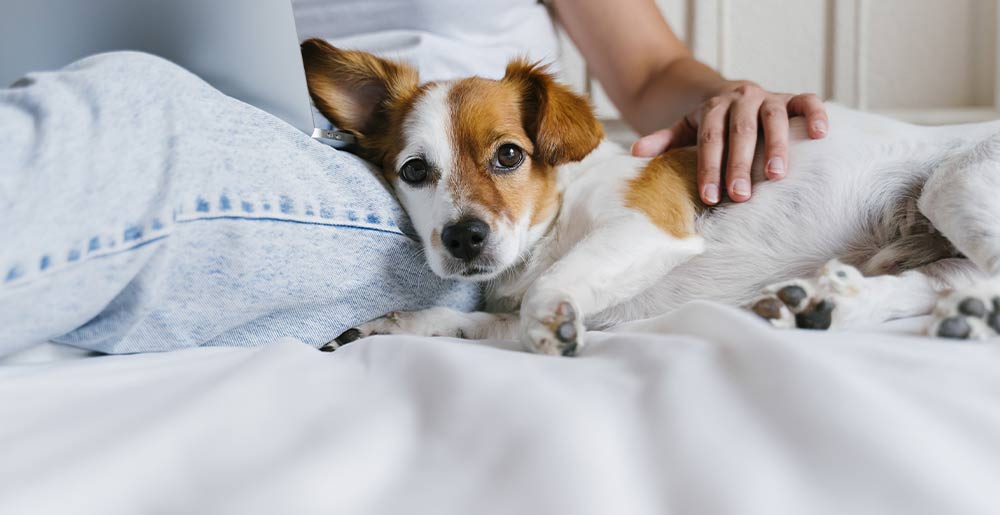Leaving your dog home alone without causing them any stress? It is difficult, but possible! Let’s find out together how we can do that, considering two preliminary recommendations and three practical tips.
An unexpected task, a business trip or a family meeting and you can’t take your dog with you: in many different situations you may have to leave your four-legged friend home alone for some hours. As we all know, it can be really hard for dogs to stay separated from their “human parent” and this may result in a real “separation anxiety” feeling. To make sure that you both experience such “temporary separation” as calmly as possible, here are two preliminary recommendations and three useful tips to follow.
Dogs home alone: two preliminary (and essential!) recommendations
We all know that dogs are very social animals. Unlike other pets, they actually need their human friend to be with them. In fact, experts say that you should never leave a puppy alone for more than three or four hours per day. It’s not even recommended to leave an adult dog alone for more than eight hours per day.
So, what would you do in case, for any reason, you have to leave your dog home alone? Don’t worry! In addition to a progressive training to staying alone (which we will analyse in detail below), there is an essential rule and three useful practical tips to remember.
What about the rule? Well, it’s easy: if you are calm, then your dog will be too. In a nutshell: our pets can feel our mood very well (we can’t hide anything from them!), so you have to be as positive and confident as possible, despite it may be hard.
If you are leaving and you are worried or anxious about this, your four-legged friend will immediately sense it, getting worried or anxious too. You better patiently try to be confident and calm them, in order to help them face the situation at their best.
Besides, do not forget that the rule above and the tips you will read below are not valid for all the single situations and experiences. If your dog has specific behavioural or educational issues, the best choice is to work with a trainer. A professional will be the right person to help you and your dog know each other better: doing this, you will both avoid frustration and you’ll be soon able to cope with such temporary separations in the best way.
Now let’s check our three practical tips. Ready, steady, go!
Before and after: three practical tips when your dog has to stay home alone
1) Before leaving them home alone: routine is essential.
If your daily routine implies the need to leave your dog home alone for some hours or the whole day, first thing to do is to properly train your dog to stay alone. Of course, you will have to be patient, but just remember that nothing is impossible: it is just a matter of… habit!
You can start your training walking away from the room where you both are, and moving to another place where your dog can see you anyway. Then you can leave them alone for a few minutes in a room and move to a place where they can’t see you anymore; from time to time, remember to increase the time they have to stay alone.
When your pet gets used to stay alone in a different room, you can try the next, most important step, that is really leaving them home alone. Start with going away just for a few minutes and then progressively increase such time, till you can safely leave them alone for hours.
2) Just before going out: arranging a safe and comfortable place.
Now it’s time to leave your dog home alone.
The following tip is quite ordinary, but still very important: before going out, make sure to arrange a safe and comfortable place for your pet. You have to leave them a bowl full of their favorite food, water and also some familiar accessories and elements (e.g. dog’s bed, blanket, pillow), which will make them feel protected while you’re out.
You also have to check that doors and windows are closed, while dangerous objects and substances (e.g. detergents, knives) must be inside locked drawers or cabinets. Finally, just before going out, do not pay extra attention to your dog and avoid overstimulating them by calling their name or with physical and visual contact. Cuddling and saying goodbye or simply talking to them may come natural, but it is better to stop a while before leaving, so that your dog can gradually get into “their bubble”.
3) Coming back home: cuddles, attentions and small prizes.
When you get back home, you have to pay the right attention to your pet, who will be super happy to be with you again.
Say no to mobile phones or other distractions; say yes to warm cuddles (tip:
cuddling your dog: pet the right body part and make them really happy).
In a nutshell, coming back home is an important moment for you both. Interaction and positive feedbacks, e.g. softly speaking to them and rewarding them, are ideal (
Snacks are perfect for such occasions). Prizing your dog for having been so good when home alone is certainly the most important incentive for them to face another similar experience in the best way. 😉

